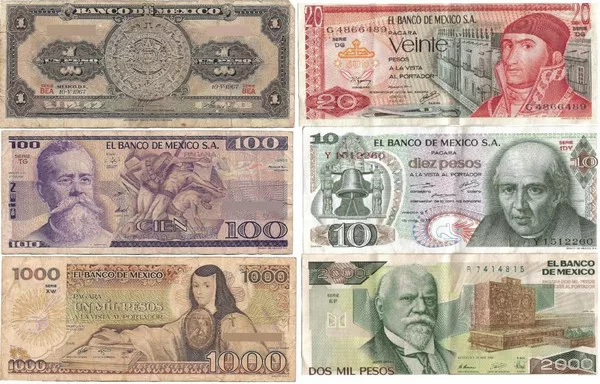The Mexican Peso (MXN) stands at the intersection of history, culture, and economics, embodying the vibrant essence of Mexico’s financial landscape. In this in-depth journey into the realm of currency, we delve into the multifaceted facets of the Mexican Peso, uncovering its historical roots, distinct currency symbol, internationally recognized currency codes, and the diverse denominations that define its physical existence. From its early days to its contemporary significance, the Mexican Peso emerges as a captivating chapter in the global narrative of currencies.
Mexican Peso Currency History
The history of the Mexican Peso is a compelling narrative that intertwines with Mexico’s economic evolution and political landscape. To comprehend the Mexican Peso’s present role, we embark on a chronological exploration of its historical trajectory.
The Mexican Peso’s story commences in the 16th century when Mexico was under Spanish rule. The Spanish dollar, or pieces of eight, served as the de facto currency in the region. Post the Mexican War of Independence in 1821, Mexico gained sovereignty, and the groundwork for a national currency was laid.
The first official Mexican coins were minted in 1823, featuring the iconic Cap and Rays design. Over the years, various iterations of the Mexican Peso emerged, reflecting economic shifts, political changes, and a commitment to monetary stability.
One significant milestone was the introduction of the Gold Peso in 1921, commemorating the centennial of Mexico’s independence. This coin, featuring the iconic Winged Victory statue, remains a symbol of national pride.
In 1993, Mexico underwent a currency reform, introducing the Nuevo Peso (MXN) to counteract hyperinflation. The term “Nuevo” was later dropped, solidifying the Mexican Peso’s place as the official currency.
Understanding the historical context allows us to appreciate the Mexican Peso’s resilience and its role as a symbol of Mexico’s economic sovereignty.
Mexican Peso Currency Symbol
Symbols hold a unique power to convey cultural identity and national pride. The Mexican Peso is represented by the symbol “$,” a familiar marker in the global lexicon of currency symbols.
The adoption of the “$” symbol is rooted in the Spanish dollar’s historical influence on Mexican currency. The dollar sign, initially representing the Pillars of Hercules and later stylized into the iconic “S” shape, found its way onto Mexican coins during the Spanish colonial era. Over time, it became synonymous with the Mexican Peso, transcending its origins to become a distinctive identifier on the international stage.
As a visual representation, the “$” symbol communicates the Mexican Peso’s identity in a universal language, bridging linguistic gaps and facilitating seamless global transactions.
Mexican Peso Currency Codes
In the intricate language of international finance, currency codes serve as the alphanumeric key to unlock the doors of global transactions. The Mexican Peso adheres to the ISO 4217 standard, employing the currency code MXN to ensure unambiguous recognition in financial dealings worldwide.
The three-letter code “MXN” is integral to banking, trade, and investment, providing a standardized method to refer to the Mexican Peso in a global context. It streamlines financial operations, reduces errors, and enhances the precision required for cross-border transactions.
Understanding the currency code’s significance is paramount for businesses, financial institutions, and individuals engaged in transactions involving the Mexican Peso. It facilitates a seamless flow of information and resources in the interconnected web of international finance.
Mexican Peso Denominations
While the digital representation of the Mexican Peso is predominant in the modern financial landscape, the physical manifestation of currency remains integral to daily transactions. The Mexican Peso exists in a diverse range of denominations, each bearing unique features that mirror Mexico’s cultural and historical narratives.
Banknotes:
20 MXN: Featuring the image of Benito Juárez, a key figure in Mexican history, this note pays homage to his contributions to the nation.
50 MXN: Showcasing the iconic muralist Diego Rivera, this note celebrates Mexico’s rich artistic heritage.
100 MXN: Depicting the enigmatic poet and nun Sor Juana Inez de la Cruz, this note recognizes Mexico’s literary legacy.
200 MXN: Featuring the revered independence leader Miguel Hidalgo, this note symbolizes Mexico’s fight for freedom.
500 MXN: Showcasing the esteemed artist Frida Kahlo, this note exemplifies Mexico’s cultural vibrancy and artistic prowess.
Coins:
1 MXN and 2 MXN Coins: Featuring iconic symbols such as the national coat of arms, these coins are essential for everyday transactions.
5 MXN and 10 MXN Coins: Bearing the image of the ancient Aztec calendar, these coins contribute to Mexico’s rich numismatic tradition.
20 MXN Coin: A commemorative coin, often issued to mark significant events or anniversaries in Mexico’s history.
Exploring these denominations offers a tangible connection to Mexico’s cultural and historical legacy, enriching the daily transactions that involve the Mexican Peso.
Conclusion
The Mexican Peso transcends its role as a mere unit of currency; it is a living testament to Mexico’s economic journey, cultural richness, and commitment to stability. From its inception as an independent nation to its contemporary status as a global currency, the Mexican Peso reflects the resilience and dynamism of the Mexican nation.
With a symbol deeply rooted in history, an internationally recognized code, and a physical presence in diverse denominations, the Mexican Peso stands as a symbol of Mexico’s identity on the global stage. Its ongoing narrative unfolds in the daily transactions, economic policies, and international interactions that shape Mexico’s position in the dynamic landscape of global finance.


